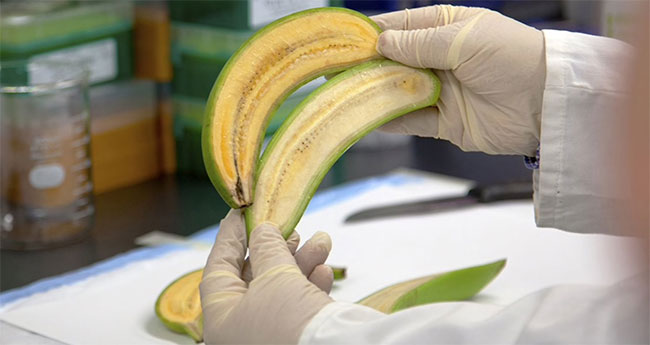The most popular banana varieties are now extinct
A fungus that is destroying banana plantations grown in the Southern Hemisphere. Although people are making efforts to prevent it, the fungus has now spread to the Americas.
According to ICA, Colombia's agriculture and livestock agency confirmed on Thursday that laboratory tests had a positive result for a disease named Panama Tropical Race 4 (TR4) - provisional translates as Tropical Panama Disease Chapter 4 , now appears at Caribbean banana farms.

Tropical Panama Disease Chapter 4 appeared at Caribbean banana farms.
The disease was discovered and diagnosed from a fungus belonging to the genus Fusarium . TR4 is a worry because bananas are not only a food source but also an export commodity. This fungus is not new, it was first identified in the 1990s in soil samples in Taiwan. This fungus has existed for a long time in Southeast Asia and Australia, but is now confirmed to be present in the Middle East and Africa since 2013. Experts are concerned that with rapid spread, they will is present in Latin America, the center of global banana exports.
"Once we recognize it, it's too late, and it's like it has spread out to outside areas while we don't receive it." Gert Kema, Professor of Tropical Plant at Wageningen University in the Netherlands, said. Until now, fungicidal and bactericidal measures have been known to prevent TR4. According to ICA, farms still do very well in preventing diseases, but removing it completely is impossible.
Farming by banana farms is also a part of making this disease stronger. Commercial banana plantations almost exclusively cultivate a clonal variety called Cavendish. Since these are identical genetic plants, it also means that it is more vulnerable to disease outbreaks because there is no genetic diversity. This monoculture technique, although economically beneficial, is partly the reason for banana populations to be susceptible to disease.

For many Latin Americans, bananas are considered a staple food, a valuable source of nutrition in everyday life.
For countries that import bananas like the United States, although this will make banana prices rise and affect some aspects, it is basically okay. For millions of Latin American or Caribbean, African, and Asian people, bananas are considered a staple food, a valuable source of nutrition in everyday life.
Cavendish banana varieties are the majority when purchased in supermarkets or markets, and people also sell local bananas. However, TR4 has a wide range of parasitic hosts, meaning it can threaten almost all breeds to a certain extent.
Currently, Latin American countries depend on bananas not only as a food source, but also affect basic economic aspects. This area has four countries that produce and export the most bananas to the market. Ecuador is the largest exporter. The expansion and spread of TR4 in the South and Central America region can seriously affect the economy of this country. The by-products from banana stems also have a few roles in people's lives.

Cavendish banana varieties are the majority when purchased in supermarkets or markets.
Previously in the early half of the 20th century, there was a similar epidemic, also known as 1st, and it swept the Gros Michel bananas, the only banana exported to the US and Europe now. . The two big men in banana cultivation, Chiquita and Dole, switched to cultivating a banana plant that they knew could resist Panama, although this type is rather bland, and this is the current Cavendish. But with the emergence of strain 4, there is a risk that this banana variety will also be wiped out.
And unlike the last time, if Cavendish is extinct, we don't have a banana variety to replace this industry. Although there are thousands of different bananas in the world, there are only a few that have the exact characteristics needed to withstand macro-trade and long-distance transport and are suitable for the international market. And now, a variety that has these advantages but is resistant to TR4 does not exist.
- This is the reason you may never eat bananas again
- Breeding new bananas to save hundreds of thousands of children worldwide
- Quang Tri restores banana varieties with high export value
- Uganda successfully studied bananas rich in nutritious carrots
- The uses of banana flowers are not everyone knows
- Admire the unique banana fruit of purple fruit in Hanoi
- This is the reason you may never eat bananas again
- Marvel at the most exotic and mysterious banana varieties in the world
- Stunned with extremely rare giant banana varieties
- Successful Japanese breeding bananas can eat the whole shell, costing 6 USD / fruit
- Banana stalks and incredible benefits
- Planting bananas without ... soil
- Breeding new bananas to save hundreds of thousands of children worldwide
- What kind of banana is the most delicious and added in Vietnam?
 Why do potatoes have eyes?
Why do potatoes have eyes? 'Tragedy' the world's largest carnivorous life: Death becomes ... public toilet
'Tragedy' the world's largest carnivorous life: Death becomes ... public toilet Tomatoes were once considered 'poisonous' for 200 years
Tomatoes were once considered 'poisonous' for 200 years Detecting microscopic parasites on human face
Detecting microscopic parasites on human face